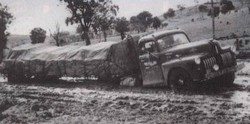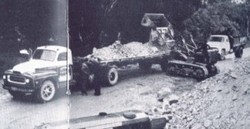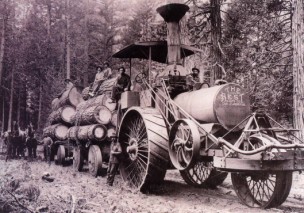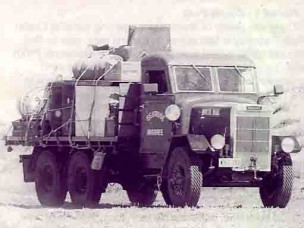If you dream it, we'll make it!
|
1906 Trentham Road
KYNETON 3444 VIC AUSTRALIA |
TRANSPORT IN AUSTRALIA
BY IAN LEE
With the first settlement a few animals arrived including horses, however because of their value, teams of convicts were used to pull, plough and cart.
As the nation grew, horses, bullocks, donkeys and camels started our transport history.
There were ships for coastal services and paddle steamers on the larger river systems.
The railways followed, in most cases run by state and Commonwealth Governments. The States were very short sited, they used different rail width , one of the worst examples was the Melbourne-Sydney line where all goods had to be transferred to and from rail trucks at the border at Albury, mostly by hand labour.
Many branch lines were extended to country towns and generally the Government was not able to cover their costs, they over borrowed to cover the cost of the system which serviced the nation reasonably well.
By the 1920’s and 1930’s motor trucks slowly started to replace the horse to areas not covered by the rail system and there were small improvements to the road system starting to take place.
Enterprising truck owners starting carting to areas which were covered by the rail system offering door to door service in days and not weeks as was the case with the railway.
As the nation grew, horses, bullocks, donkeys and camels started our transport history.
There were ships for coastal services and paddle steamers on the larger river systems.
The railways followed, in most cases run by state and Commonwealth Governments. The States were very short sited, they used different rail width , one of the worst examples was the Melbourne-Sydney line where all goods had to be transferred to and from rail trucks at the border at Albury, mostly by hand labour.
Many branch lines were extended to country towns and generally the Government was not able to cover their costs, they over borrowed to cover the cost of the system which serviced the nation reasonably well.
By the 1920’s and 1930’s motor trucks slowly started to replace the horse to areas not covered by the rail system and there were small improvements to the road system starting to take place.
Enterprising truck owners starting carting to areas which were covered by the rail system offering door to door service in days and not weeks as was the case with the railway.

Typical view from the drivers seat of a horse wagon team. The two horses with the saddles are in the shafts and the other nine are pulling with a series of chains and swingle bars.
At the end of World War 1, returned servicemen had seen trucks working for the war effort including the famous Mack AC models, Diamond T and Liberty trucks for the war effort, plus all the other makers, by the 1930’s further improvements were available, world production increased and costs improved and the road transport system quickly proved faster and cheaper than the horse or bullock teams, and the birth of the trucking industry began.
The truck driver like his truck came in all shapes and sizes, he often seemed different to the every day person, a rare mix of a person, sometimes rowdy, but always willing to lend a hand to the less fortunate he met on his travels.
As time passed, the size of his truck and load dwarfed the horse and cart. Its speed noise and dust drove fear into other animals on the roadway and our learned fathers were quick to legislate controls to slow down the progress of this new beast which could run day and night without rest.
Then the new transport beast began to deliver goods at times and costs not considered possible, store owners found goods which took weeks to come by rail were available in a day or two with motor trucks, and their customers were quick to enjoy this door to door service, which this new self employed business person could offer.
Other businesses en route were quick to embrace the services available, as unlike the railways he had his repairs and service done locally including fuel and tyres, a further benefit to the local community.
The Government however were slow to see the value in a better system which gave service, value for money and required no Government subsidies (today we know it took them a further 60 years to deregulate the transport industry).
Their concerns were the loss of freight to their ageing poorly planned and operated railway system, burdened with excessive capital and borrowings, the Government quickly legislated to stop transport competing and formed the Transport Regulation Board in the early 1920’s.
In Carl Beer’s book Pioneering Trucking Day of the Victorian Mallee refers to the TRB as the grey ghosts with their grey dust coats, TRB badges and Chevrolet cars. They introduced speed limits of 12 mph for solid tyres vehicles and 15mph for pneumatic tyred trucks.
The truck driver like his truck came in all shapes and sizes, he often seemed different to the every day person, a rare mix of a person, sometimes rowdy, but always willing to lend a hand to the less fortunate he met on his travels.
As time passed, the size of his truck and load dwarfed the horse and cart. Its speed noise and dust drove fear into other animals on the roadway and our learned fathers were quick to legislate controls to slow down the progress of this new beast which could run day and night without rest.
Then the new transport beast began to deliver goods at times and costs not considered possible, store owners found goods which took weeks to come by rail were available in a day or two with motor trucks, and their customers were quick to enjoy this door to door service, which this new self employed business person could offer.
Other businesses en route were quick to embrace the services available, as unlike the railways he had his repairs and service done locally including fuel and tyres, a further benefit to the local community.
The Government however were slow to see the value in a better system which gave service, value for money and required no Government subsidies (today we know it took them a further 60 years to deregulate the transport industry).
Their concerns were the loss of freight to their ageing poorly planned and operated railway system, burdened with excessive capital and borrowings, the Government quickly legislated to stop transport competing and formed the Transport Regulation Board in the early 1920’s.
In Carl Beer’s book Pioneering Trucking Day of the Victorian Mallee refers to the TRB as the grey ghosts with their grey dust coats, TRB badges and Chevrolet cars. They introduced speed limits of 12 mph for solid tyres vehicles and 15mph for pneumatic tyred trucks.
HISTORY HAS NEGLECTED THE TRUCK
Transport can be described largely as the movement of goods and people from origin to a destination. Without transportation there would be no food or materials for building and manufacturing, every matter or type of goods we use every day, they involve the transport industry.
Road transport is the core industry these days, delivering in excess of 1.5 million tonnes of road freight each year.
Road transport is the core industry these days, delivering in excess of 1.5 million tonnes of road freight each year.
DIESEL POWERED TRUCKS
Today large and small trucks are diesel powered, however in 1955 only 888 of the 17,444 trucks registrations had diesel power and mostly of British origin and often very slow, even though diesel was much cheaper than petrol. Transport operators were slow to use diesel powered trucks.
Misunderstanding and cost were big factors, a diesel driver was most likely to be a new Australian and at times easily recognised by their dark appearance, this often had no bearing on their race.
Diesel engines generally leaked a lot of oil and some of this found its way into the cabin, outside on the tarps, the trailers were black with smoke, the chassis oily, everything was very dirty.
Misunderstanding and cost were big factors, a diesel driver was most likely to be a new Australian and at times easily recognised by their dark appearance, this often had no bearing on their race.
Diesel engines generally leaked a lot of oil and some of this found its way into the cabin, outside on the tarps, the trailers were black with smoke, the chassis oily, everything was very dirty.
NEW REGISTRATIONS – TYPE OF FUEL USED
|
State/Territory
Trucks -
NSW VIC QLD SA WA TASMANIA N.T. ACT TOTAL 1955 TOTAL 1954 Buses – NSW VIC QLD S.A. W.A. TASMANIA A.C.T. TOTAL 1955 TOTAL 1954 |
Petrol
5928 4629 2360 2048 1656 675 79 69 17.444 15.822 Petrol 72 116 41 56 21 3 1 350 285 |
Diesel
295 214 76 64 96 28 12 3 888 627 Diesel 21 26 15 66 7 1 - 155 108 |
Total
6323 4843 2436 2112 1752 703 91 72 18.322 16.44 Total 93 142 56 122 28 4 1 505 393 |
1956 Break-away systems for semi trailers. Mr Pockett advised that the Committee will consider the following new laws.
- Automatic application of trailer brakes in the case where a trailer breaks away from the prime mover.
- Compulsory provision of vacuum tanks for vacuum assisted braking systems and air and vacuum hose standards.
- Consideration would be give to the suggestion that all vehicles be required to carry dual rear lamps.
- The conference will discuss a proposal relating to measures designed to ensure good quality vehicles fittings being available to operators.
- Complaints relating to the hazards to other road users arising from the operation of heavy diesel vehicles with incorrectly serviced or poorly maintained exhaust systems.
- Other items on the agenda include blinking light trafficators be fitted to trucks.
- The New South Wales Premier Mr Cahill said Government was considering the introduction of a Tax to interstate haulers.
- Ford advertisement 1956 for truck turn indicators which would be mounted on the front and rear of the truck and trailer, this new safety turning device is acknowledged as a legal alternative.
- 1956 petrol prices for standard in capital cities averaged 3 shilling and 7 pence, this includes a Federal Tax of 1 shilling 2 ¾ pence per gallon.

White 3022- Circa 1956
This was a big rig in its day with 145hp engine hitched up to a purpose built pantech manufactured on a freighter trailer by the trucks owners, A. Blackmore of Sydney. Two of these Whites were used on the Sydney-Melbourne interstate runs taking 36 hours each way.
Between July 11 and 24 1956, road traffic between Melbourne and Sydney was completely cut at Little Billabong, between Holbrook and Tarcutta on the Hume Highway when near record rains and heavy traffic brought about the collapse of large sections of the roadway. Long stretches of road were turned into deep bogs.
Between July 11 and 24 1956, road traffic between Melbourne and Sydney was completely cut at Little Billabong, between Holbrook and Tarcutta on the Hume Highway when near record rains and heavy traffic brought about the collapse of large sections of the roadway. Long stretches of road were turned into deep bogs.

Trucks became bogged on the highway which linked Melbourne and Sydney in 1956
Immediately a five ton ban was placed on alternate roads through Wagga closing heavy commercial road transport between the two cities.
Officials counted 210 trucks at Tarcutta, 29 at Gundagai, 29 at Tumblong and 77 at Holbrook, in addition to many at Wagga, Albury etc. Loads of perishables began to deteriorate. Drivers put up with extreme discomfort, many ran out of money, residents in some towns organised food relief kitchens.
In the meantime the Main Roads Department were pouring hundreds of tons of blue metal into the bog, but it disappeared into the mud. Stranded drivers protested strongly at the slowness of the repairs employed by the authority.
Officials counted 210 trucks at Tarcutta, 29 at Gundagai, 29 at Tumblong and 77 at Holbrook, in addition to many at Wagga, Albury etc. Loads of perishables began to deteriorate. Drivers put up with extreme discomfort, many ran out of money, residents in some towns organised food relief kitchens.
In the meantime the Main Roads Department were pouring hundreds of tons of blue metal into the bog, but it disappeared into the mud. Stranded drivers protested strongly at the slowness of the repairs employed by the authority.

A stranded International R 180 semi trailer used to assist in the temporary repairs being loaded by a TD9 Drott.
It would be interesting to know how it was unloaded, I assume by hand, it was common in this period to shovel off the loads. The better equipped trucks had steel floors slightly raised in the centre with drop sides to reduce the effort, generally after unloading on side you turned around to get the load in the centre of the roadway or stack site.
Divorce was rare and shunned, television sets were an expensive novelty, Sunday was reserved for church, hotels closed at 6 o’clock, few women with children worked.
We now live longer but marry later, have less children, we are 4 times as likely to live alone, car ownership has soared, we use public transport less.
Divorce was rare and shunned, television sets were an expensive novelty, Sunday was reserved for church, hotels closed at 6 o’clock, few women with children worked.
We now live longer but marry later, have less children, we are 4 times as likely to live alone, car ownership has soared, we use public transport less.
|
Lee No.3 Pty Ltd
Trading since 1961 ACN: 005 204 599 ABN: 40 005 204 599 |
For more information please contact Ian Lee on 0428 507 408 [email protected] |
PO Box 614
KYNETON 3444 VICTORIA, AUSTRALIA |


